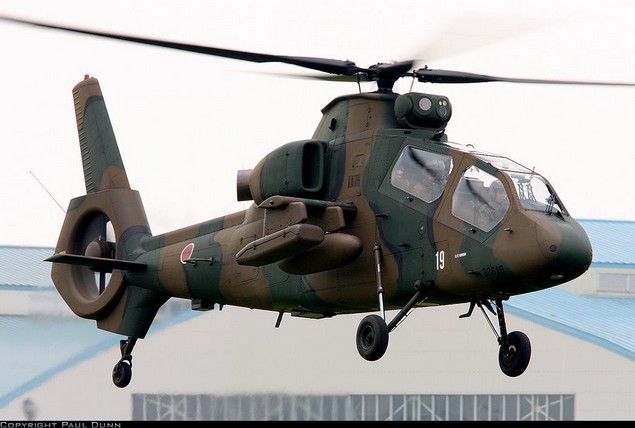Kawasaki OH1
From the mid-1980s the Japan Defence Agency (JDA), began to consider a successor to the OH-6D light helicopters currently in service with the Japanese Ground Self-Defence Force. It was decided to procure an indigenous type for the scout/reconnaissance roles. In 1992 Kawasaki was selected as prime contractor with 60 percent of the programme, the balance being allocated equally between Fuji and Mitsubishi. The three companies established the Observation Helicopter Engineering Team to develop the programme, on which detailed work began in 1992. The resulting OH-1, nicknamed Ninja, is a conventional machine that is relatively small and of typical gunship helicopter configuration. Its structure comprises, by weight, 40 per cent carbonfibre-reinforced plastics, and it features a fenestron type tail rotor.
The resulting OH-1, nicknamed Ninja, is a conventional machine that is relatively small and of typical gunship helicopter configuration. Its structure comprises, by weight, 40 per cent carbonfibre-reinforced plastics, and it features a fenestron type tail rotor.
Each crew member has two LCD colour multi-function displays, and the gunner has a head-up display. The mission avionics include a trainable roof-mounted Kawasaki package (forward of the main rotor) with a Fujitsu thermal imager, NEC colour TV camera and NEC laser rangefinder. Protection is enhanced by the installation of an infra-red jammer on the helicopter's spine to rear of the main gearbox.
The first of six prototypes made its initial flight on 6 August 1996, and the first of a possible 150 to 200 OH-1s was delivered to the JGSDF on 24 January 2000. A total of 14 OH-1s has been ordered for delivery by 2001. The JDA may revise the OH-1 to meet its AH-X light attack helicopter requirement. This would probably feature MTR-390 or T800 engines, allowing the introduction of a heavier weapons load and revised mission avionics. The projected designation of the AH-X production model is AH-2.
Name 'Ninja' reportedly given in 2002, but not officially confirmed.
Current Versions:
OH-1; Basic initial production version; as described.
Growth versions: Under study with more powerful engines (possibly LHTEC T800 or R-R/Turbomeca/MTU MTR 390) and uprated gearbox. OH-1Kai is possible candidate for AH-X requirement with tentative designation AH-2, armour-plated forward and centre fuselage, upgraded engines and transmission and additional weapons carriage.
CUSTOMERS; Total of 20, including prototypes, ordered by FY02; at least 12 delivered by late 2002. Japan Ground Self-Defence hoice requirement for 150 to 200.
Hiko Jikkentai (Flight Test Squadron) formed at Akeno with first four production aircraft on 27 March 2001; other deliveries by late 2002 included small numbers to Kasumigaura Bunko, Utsunomiya Bunko and Kyoiku Shien Hikotai (at Akeno), all of which are departments of the Army's Koku Gako (Aviation School).
Costs: Funding for development, prototypes and flight testing Y2.5 billion in FY92, Y10.2 billion in FY93, Y50.1 billion in bY94 and Y23.3 billion in FY95. Unit costs of first four production lots Y1.924 billion (FY97), Y2.018 billion (FY9S), Y2.229 billion (FY99) and Y2.075 billion (FY00).
Design Features: Kawasaki hingeless, bearingless and 20mm ballistic-tolerant four-blade elastomeric main rotor and transmission system; Fenestron-type tail rotor with eight unevenly angled 'scissor' blades (35 and 55°); stub-wings for stores carriage. Active vibration damping system.
Fliying controls: Integrated AFCS and stability control augmentation system (SCAS).
Structure: Rotor blades and hub manufactured from GFRP composites; centre-fuselage and engines by Mitsubishi, tail umt/canopy/stub-wings/cowling by Fuji, rest by Kawasaki. Some 37% of airframe (by weight) in GFRP/CFRP.
Landing Gear: Non-retractable tailwheel type. Provision for wheel/skis on main units.
Power Plant: Twin 662kW FADEC-equipped Mitsubishi TS1-10QT turboshafts (XTS1-10 originally in prototypes). Possibility of off-the-shelf alternative engines not ruled out. Transmission has 30-rninute run-dry capability. Stub-wings can each carry a 235 litre auxiliary fuel tank.
Accomodation: Crew of two on tandem armoured seats (pilot in front). Flat-plate cockpit transparencies, upward-opening on starboard side for crew access.
Avionics:
Flight: AFCS with stability augmentation and holding functions; dual HOCAS controls.
Instrumentation: Two Yokogawa Electric large, fiat-panel, liquid crystal colour MFDs in each cockpit, linked to a MIL-STD-1553B databus; Shimadzu HUD in front cockpit.
Mission: Kawasaki electrically operated roof-mounted turret combining Fujitsu thermal imager, NEC real-time colour TV camera and NEC laser range-finder/designator: field of regard 110° in azimuth, 40° in elevation.
Self-defence: Spine-mounted IR jammer based on BAE Systems AN/ALQ-144.
Armament: Four Toshiba Type 91 (modified) lightweight short-range, IR-guided AAMs on pylons under stub-wings for sell-defence.
Technical data for OH-1
Main rotor diameter: 11.6m,
fuselage length: 12.0m,
height to top of rotor head: 3.4m,
height over tailfin: 3.8m,
empty weight: 2450kg,
normal take-off weight: 3550kg,
max take-off weight: 4000kg,
max level speed: 277km/h,
combat radius: 200km,
range: 550km

